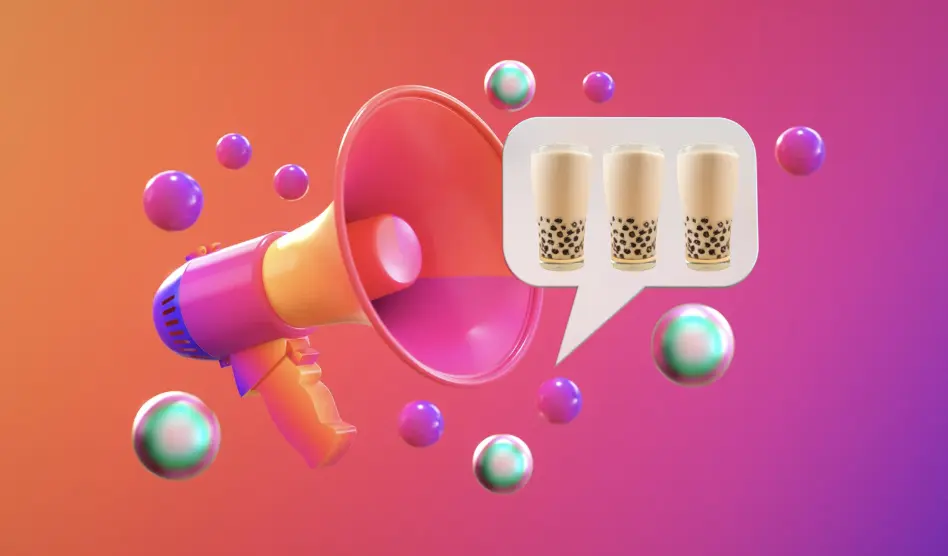Bubble tea, also known as boba, is no longer just a niche Asian drink.
It’s a booming global market, and in the U.S., demand continues to rise as Gen Z and Millennials embrace this colorful, customizable beverage culture.
If you've ever dreamed of launching your own bubble tea shop, this may be your perfect year.

In this comprehensive startup guide, we’ll walk you through everything you need to know about the bubble tea shop business: from concept and location to tech tools and budgeting.
Whether you're a first-time entrepreneur or a seasoned restaurateur exploring the bubble tea space, this guide will help you launch with confidence.
Bubble tea has evolved from a novelty into a $3 billion industry in the U.S. alone, and it's projected to grow steadily through 2030.
From fruity slushes to cheese foam toppings and oat milk alternatives, today's customers are looking for both tradition and innovation.
The cultural appeal of bubble tea also extends beyond its dynamic flavors.
It's a social experience.
Bubble tea shops have become community hubs where people gather to enjoy a fun, vibrant atmosphere.
The aesthetic presentation of the drinks themselves, often shared on social media, serves as free advertising and grows your shop's online presence.
Compared to full-scale restaurants, bubble tea shops typically have lower startup costs, smaller footprints, and faster turnaround times.
With customizable drink options, you can easily attract a loyal customer base with the right flavors, presentation, and experience.
But customization doesn't stop at ingredients.
Personalizing the experience with interactive and intuitive online ordering systems and loyalty programs keeps customers engaged.
These platforms can manage complex drink modifications efficiently, ensuring each order is crafted to perfection while reducing wait times - a critical factor in customer satisfaction.

Before you pour your first cup of tea, you need to clearly define your brand.
Pro Tip: Create buyer personas and tailor your offerings, branding, and marketing to their habits and preferences so you can find your niche market.
A strong business plan sets the foundation for your success and is essential if you're seeking external financing.
You can use this business plan to determine breakeven points, profitability windows, and investor readiness.
Opening a boba tea business in 2025 requires a well-planned budget that reflects not only equipment and rent but also digital infrastructure, staff training, and working capital.
Startup costs will vary depending on your location, store size, and brand vision whether you’re launching a kiosk based shop or a full-scale flagship store.
Rent & Lease Deposit
$3,000 – $10,000/month
Renovation & Interior Design
$10,000 – $50,000
Equipment & Appliances
$15,000 – $30,000
Initial Inventory & Supplies
$3,000 – $8,000
Licenses & Permits
$2,000 – $5,000
Staff Hiring & Training
$5,000 – $10,000
Marketing & Branding
$2,000 – $7,000
POS System & Software
$2,000 – $5,000
Contingency Fund
$5,000 – $10,000
Total Estimate
$47,000 – $135,000
💡 Tip: Keep a 3-month buffer for operating costs after opening.
MenuSifu’s integrated solution reduces long-term costs by:
Location is everything.
*Especially for a business that depends on foot traffic and quick-service orders.
Consider visibility, accessibility, parking, and local competition.
A smaller footprint is fine—as long as your boba tea shop layout supports high volume and workflow.
Menu strategy goes far beyond drink names.
It impacts operations, cost control, and customer behavior.
Use Menu Engineering tactics to design for upselling.
For example, group high-margin items, visually highlight seasonal specials, and make combos simple to order.
Your brand needs to feel intentional, especially for a younger customer base who value aesthetic, story, and customer experience.
Hire a designer or branding expert if needed.
Every customer interaction should feel cohesive, from online orders to takeout cups.

Don't skip the paperwork!!!
Operating without the right licenses can lead to fines or shutdowns.
It's always a good idea to consult a local accountant or legal advisor to ensure all state and county-level regulations are met.
A reliable supply chain is vital to consistency. Invest in high-quality equipment and dependable partners.
💡 MenuSifu’s bubble tea POS solution integrates with your ordering and kitchen systems, minimizing errors and speeding up service.
You should always vet suppliers for lead times, storage requirements, and cost fluctuations, as well as find multiple options so you always have a backup.
In 2025, digital tools are essential for growth, efficiency, and customer satisfaction.
MenuSifu’s bubble tea POS system is designed specifically for high-volume beverage shops.
It features:

Staff are the face of your brand.
Train them to deliver consistently great service even during rushes.
Pro Tip: Positive, efficient teams lead to better customer reviews, repeat business, and lower turnover.
It's important to track your performance and build on it with a post-launch marketing plan: SMS campaigns, seasonal drinks, and feedback surveys.
Opening a boba tea shop in 2025 is an exciting, rewarding journey, but it’s also competitive and fast-moving.
With the right planning, technology, and vision, you can build a business that not only serves great drinks but creates a loyal community.
Use this guide as your roadmap—from concept to grand opening—and revisit it often as your business grows.
And remember, you're not in it alone.
MenuSifu is here to support you with POS systems, online ordering, kiosk solutions, loyalty programs, and real-time business insights tailored for the bubble tea industry.
Because behind every successful boba shop is a powerful operational system that keeps the experience smooth, sweet, and scalable.

You Might Also Enjoy These Articles:
2025 Updated Restaurant Tax Regulations - What Every Restaurant Owner Needs to Know
Tax Season Survival Guide for Restaurants - Maximize Deductions in 2025
What is a Barback? Skills, Duties & Career Growth Explained
10 Key Benefits of a Cloud-Based POS System
How to Open a Juice Bar in 2025 - Ultimate Startup Guide
The Ultimate POS System for Bubble Tea Shops
How iPad POS Systems Are Revolutionizing Restaurant Operations in 2025
What is a Bartender - Careers in 2025
Restaurant Tech Trends 2025: AI & Automation Revolutionizing POS Systems
6 Must Have POS Software Features - Chinese Restaurants
8 Key Restaurant Leasing Trends of 2025 - What's Changing and How to Stay Ahead
What is a Pastry Chef? Role, Skills, and Career Tips for 2025
Restaurant Email Marketing Strategies - Winning over Customers in 2025
How to Encourage Return Customers in 2025 - Proven Tips & Tricks
Best POS System for Quick Service Restaurants - Top 10 Q&A’s
What is a Barista? Essential Skills to Excel in 2025
How to Open a Fast Food Restaurant - Be the Next Big Thing!
8 Restaurant Management Books to Transform Your Thinking and Leadership
What is an Executive Chef? - Kitchen Hierarchy
What Does a Host Do at a Restaurant?
How Do you Open a Franchise Restaurant in 6 Simple Steps - 2024 Guide
24 Effective Restaurant Advertising Ideas for 2024